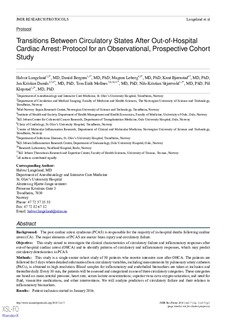| dc.contributor.author | Langeland, Halvor | |
| dc.contributor.author | Bergum, Daniel | |
| dc.contributor.author | Løberg, Magnus | |
| dc.contributor.author | Bjørnstad, Knut | |
| dc.contributor.author | Damås, Jan Kristian | |
| dc.contributor.author | Mollnes, Tom Eirik | |
| dc.contributor.author | Skjaervold, Nils Kristian | |
| dc.contributor.author | Klepstad, Pål | |
| dc.date.accessioned | 2018-03-08T12:33:15Z | |
| dc.date.available | 2018-03-08T12:33:15Z | |
| dc.date.created | 2018-03-07T13:53:04Z | |
| dc.date.issued | 2018 | |
| dc.identifier.citation | JMIR Research Protocols. 2018, 7 . | nb_NO |
| dc.identifier.issn | 1929-0748 | |
| dc.identifier.uri | http://hdl.handle.net/11250/2489504 | |
| dc.description.abstract | Background: The post cardiac arrest syndrome (PCAS) is responsible for the majority of in-hospital deaths following cardiac arrest (CA). The major elements of PCAS are anoxic brain injury and circulatory failure.
Objective: This study aimed to investigate the clinical characteristics of circulatory failure and inflammatory responses after out-of-hospital cardiac arrest (OHCA) and to identify patterns of circulatory and inflammatory responses, which may predict circulatory deterioration in PCAS.
Methods: This study is a single-center cohort study of 50 patients who receive intensive care after OHCA. The patients are followed for 5 days where detailed information from circulatory variables, including measurements by pulmonary artery catheters (PACs), is obtained in high resolution. Blood samples for inflammatory and endothelial biomarkers are taken at inclusion and thereafter daily. Every 10 min, the patients will be assessed and categorized in one of three circulatory categories. These categories are based on mean arterial pressure; heart rate; serum lactate concentrations; superior vena cava oxygen saturation; and need for fluid, vasoactive medications, and other interventions. We will analyze predictors of circulatory failure and their relation to inflammatory biomarkers.
Results: Patient inclusion started in January 2016.
Conclusions: This study will obtain advanced hemodynamic data with high resolution during the acute phase of PCAS and will analyze the details in circulatory state transitions related to circulatory failure. We aim to identify early predictors of circulatory deterioration and favorable outcome after CA.
Trial Registration: ClinicalTrials.gov: NCT02648061; https://clinicaltrials.gov/ct2/show/NCT02648061 (Archived by WebCite at http://www.webcitation.org/6wVASuOla) | nb_NO |
| dc.language.iso | eng | nb_NO |
| dc.publisher | JMIR Publications | nb_NO |
| dc.rights | Navngivelse 4.0 Internasjonal | * |
| dc.rights.uri | http://creativecommons.org/licenses/by/4.0/deed.no | * |
| dc.title | Transitions Between Circulatory States After Out-of-Hospital Cardiac Arrest: Protocol for an Observational, Prospective Cohort Study | nb_NO |
| dc.type | Journal article | nb_NO |
| dc.type | Peer reviewed | nb_NO |
| dc.description.version | publishedVersion | nb_NO |
| dc.source.pagenumber | 11 | nb_NO |
| dc.source.volume | 7 | nb_NO |
| dc.source.journal | JMIR Research Protocols | nb_NO |
| dc.identifier.doi | 10.2196/resprot.8558 | |
| dc.identifier.cristin | 1571117 | |
| dc.description.localcode | © The Author(s) 2018. This article is distributed under the terms of the Creative Commons Attribution 4.0 International License (http://creativecommons.org/licenses/by/4.0/) | nb_NO |
| cristin.unitcode | 194,65,25,0 | |
| cristin.unitcode | 194,65,15,0 | |
| cristin.unitname | Institutt for sirkulasjon og bildediagnostikk | |
| cristin.unitname | Institutt for klinisk og molekylær medisin | |
| cristin.ispublished | true | |
| cristin.fulltext | original | |
| cristin.qualitycode | 1 | |

